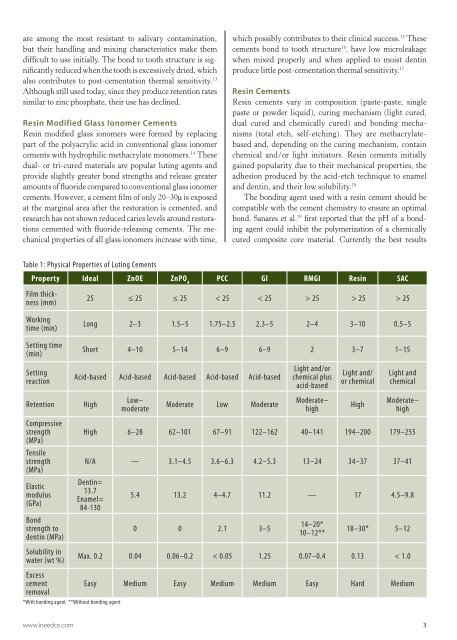A Practical Guide to the Use of Luting Cements - IneedCE.com
A Practical Guide to the Use of Luting Cements - IneedCE.com
A Practical Guide to the Use of Luting Cements - IneedCE.com
You also want an ePaper? Increase the reach of your titles
YUMPU automatically turns print PDFs into web optimized ePapers that Google loves.
are among <strong>the</strong> most resistant <strong>to</strong> salivary contamination,<br />
but <strong>the</strong>ir handling and mixing characteristics make <strong>the</strong>m<br />
difficult <strong>to</strong> use initially. The bond <strong>to</strong> <strong>to</strong>oth structure is significantly<br />
reduced when <strong>the</strong> <strong>to</strong>oth is excessively dried, which<br />
also contributes <strong>to</strong> post-cementation <strong>the</strong>rmal sensitivity. 13<br />
Although still used <strong>to</strong>day, since <strong>the</strong>y produce retention rates<br />
similar <strong>to</strong> zinc phosphate, <strong>the</strong>ir use has declined.<br />
Resin Modified Glass Ionomer <strong>Cements</strong><br />
Resin modified glass ionomers were formed by replacing<br />
part <strong>of</strong> <strong>the</strong> polyacrylic acid in conventional glass ionomer<br />
cements with hydrophilic methacrylate monomers. 14 These<br />
dual- or tri-cured materials are popular luting agents and<br />
provide slightly greater bond strengths and release greater<br />
amounts <strong>of</strong> fluoride <strong>com</strong>pared <strong>to</strong> conventional glass ionomer<br />
cements. However, a cement film <strong>of</strong> only 20–30μ is exposed<br />
at <strong>the</strong> marginal area after <strong>the</strong> res<strong>to</strong>ration is cemented, and<br />
research has not shown reduced caries levels around res<strong>to</strong>rations<br />
cemented with fluoride-releasing cements. The mechanical<br />
properties <strong>of</strong> all glass ionomers increase with time,<br />
which possibly contributes <strong>to</strong> <strong>the</strong>ir clinical success. 15 These<br />
cements bond <strong>to</strong> <strong>to</strong>oth structure 16 , have low microleakage<br />
when mixed properly and when applied <strong>to</strong> moist dentin<br />
produce little post-cementation <strong>the</strong>rmal sensitivity. 17<br />
Resin <strong>Cements</strong><br />
Resin cements vary in <strong>com</strong>position (paste-paste, single<br />
paste or powder liquid), curing mechanism (light cured,<br />
dual cured and chemically cured) and bonding mechanisms<br />
(<strong>to</strong>tal etch, self-etching). They are methacrylatebased<br />
and, depending on <strong>the</strong> curing mechanism, contain<br />
chemical and/or light initia<strong>to</strong>rs. Resin cements initially<br />
gained popularity due <strong>to</strong> <strong>the</strong>ir mechanical properties, <strong>the</strong><br />
adhesion produced by <strong>the</strong> acid-etch technique <strong>to</strong> enamel<br />
and dentin, and <strong>the</strong>ir low solubility. 18<br />
The bonding agent used with a resin cement should be<br />
<strong>com</strong>patible with <strong>the</strong> cement chemistry <strong>to</strong> ensure an optimal<br />
bond. Sanares et al. 19 first reported that <strong>the</strong> pH <strong>of</strong> a bonding<br />
agent could inhibit <strong>the</strong> polymerization <strong>of</strong> a chemically<br />
cured <strong>com</strong>posite core material. Currently <strong>the</strong> best results<br />
Table 1: Physical Properties <strong>of</strong> <strong>Luting</strong> <strong>Cements</strong><br />
Property Ideal ZnOE ZnPO 4<br />
PCC GI RMGI Resin SAC<br />
Film thickness<br />
(mm)<br />
25 ≤ 25 ≤ 25 < 25 < 25 > 25 > 25 > 25<br />
Working<br />
time (min)<br />
Long 2–3 1.5–5 1.75–2.5 2.3–5 2–4 3–10 0.5–5<br />
Setting time<br />
(min)<br />
Setting<br />
reaction<br />
Retention<br />
Compressive<br />
strength<br />
(MPa)<br />
Tensile<br />
strength<br />
(MPa)<br />
Elastic<br />
modulus<br />
(GPa)<br />
Bond<br />
strength <strong>to</strong><br />
dentin (MPa)<br />
Solubility in<br />
water (wt %)<br />
Excess<br />
cement<br />
removal<br />
Short 4–10 5–14 6–9 6–9 2 3–7 1–15<br />
Acid-based Acid-based Acid-based Acid-based Acid-based<br />
High<br />
Low–<br />
moderate<br />
Moderate Low Moderate<br />
Light and/or<br />
chemical plus<br />
acid-based<br />
Moderate–<br />
high<br />
Light and/<br />
or chemical<br />
High<br />
Light and<br />
chemical<br />
Moderate–<br />
high<br />
High 6–28 62–101 67–91 122–162 40–141 194–200 179–255<br />
N/A — 3.1–4.5 3.6–6.3 4.2–5.3 13–24 34–37 37–41<br />
Dentin=<br />
13.7<br />
Enamel=<br />
84-130<br />
*With bonding agent **Without bonding agent<br />
5.4 13.2 4–4.7 11.2 — 17 4.5–9.8<br />
0 0 2.1 3–5<br />
14–20*<br />
10–12**<br />
18–30* 5–12<br />
Max. 0.2 0.04 0.06–0.2 < 0.05 1.25 0.07–0.4 0.13 < 1.0<br />
Easy Medium Easy Medium Medium Easy Hard Medium<br />
www.ineedce.<strong>com</strong> 3
















